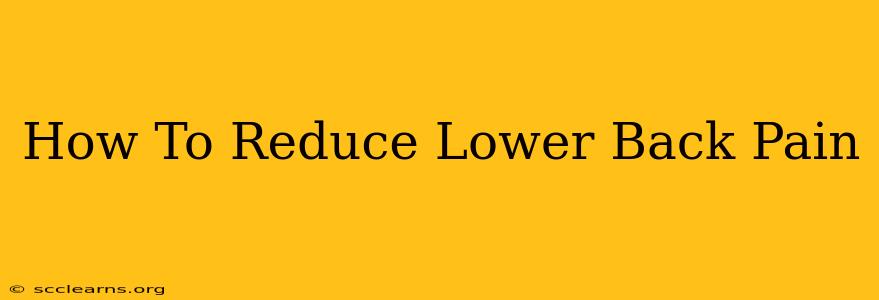Lower back pain is a common ailment affecting millions worldwide. It can range from a mild ache to a debilitating condition, significantly impacting daily life. Fortunately, there are numerous ways to reduce and even eliminate lower back pain. This comprehensive guide explores effective strategies to alleviate your discomfort and improve your overall well-being.
Understanding Lower Back Pain
Before diving into solutions, it's crucial to understand the potential causes of lower back pain. While simple strains and sprains are common culprits, other factors can contribute, including:
- Muscle strains: Overexertion, poor posture, or sudden movements can strain back muscles.
- Ligament sprains: These injuries occur when ligaments supporting the spine are overstretched or torn.
- Disc problems: Herniated or bulging discs can put pressure on nerves, causing pain that radiates down the leg (sciatica).
- Arthritis: Osteoarthritis and other forms of arthritis can inflame the joints in the spine.
- Spinal stenosis: Narrowing of the spinal canal can compress nerves, leading to pain and numbness.
- Poor posture: Consistently slouching or maintaining awkward positions puts undue stress on your lower back.
- Obesity: Excess weight increases the load on your spine.
- Stress: Psychological stress can exacerbate muscle tension and pain.
Effective Ways to Reduce Lower Back Pain
Now, let's explore effective methods to manage and reduce your lower back pain:
1. Lifestyle Modifications: The Cornerstone of Relief
Implementing these lifestyle changes can significantly impact your lower back pain:
- Maintain a Healthy Weight: Losing even a small amount of weight can dramatically reduce the strain on your lower back.
- Improve Your Posture: Practice good posture while sitting, standing, and walking. Consider ergonomic chairs and supportive surfaces.
- Regular Exercise: Gentle exercise strengthens core muscles, which provide crucial support for your spine. Activities like yoga, Pilates, and swimming are particularly beneficial. Avoid high-impact exercises that could aggravate your pain.
- Ergonomic Workplace: Ensure your workspace is ergonomically designed to minimize strain on your back. This includes proper chair height, monitor placement, and keyboard positioning.
- Stress Management: Practice relaxation techniques like deep breathing, meditation, or yoga to reduce stress levels, which can contribute to muscle tension and back pain.
2. Over-the-Counter Pain Relief
Over-the-counter medications can provide temporary relief from lower back pain:
- Nonsteroidal anti-inflammatory drugs (NSAIDs): Ibuprofen and naproxen can reduce inflammation and pain. Always follow the recommended dosage.
- Topical analgesics: Creams and gels containing menthol or capsaicin can provide localized pain relief.
3. Heat and Ice Therapy
Applying heat or ice can help manage lower back pain:
- Heat: A heating pad or warm bath can relax muscles and ease pain. Use heat for longer durations, up to 20 minutes at a time.
- Ice: Ice packs can reduce inflammation and numb the area. Apply ice for 15-20 minutes at a time, several times a day. Never apply ice directly to the skin.
4. Physical Therapy
A physical therapist can create a personalized exercise program to strengthen your core muscles, improve flexibility, and correct postural imbalances. They can also teach you stretches and exercises to perform at home.
5. Medical Interventions
In severe cases, a doctor may recommend:
- Prescription medications: Stronger pain relievers or muscle relaxants may be necessary.
- Injections: Corticosteroid injections can reduce inflammation in the spine.
- Surgery: Surgery is typically a last resort for severe cases that haven't responded to other treatments.
When to See a Doctor
Consult a doctor if your lower back pain:
- Is severe or persistent.
- Radiates down your leg.
- Is accompanied by numbness or weakness.
- Is accompanied by fever or weight loss.
- Doesn't improve after a few weeks of home treatment.
Disclaimer: This information is for educational purposes only and should not be considered medical advice. Always consult with a healthcare professional before starting any new treatment for lower back pain. They can properly diagnose the cause of your pain and recommend the most appropriate course of action.

